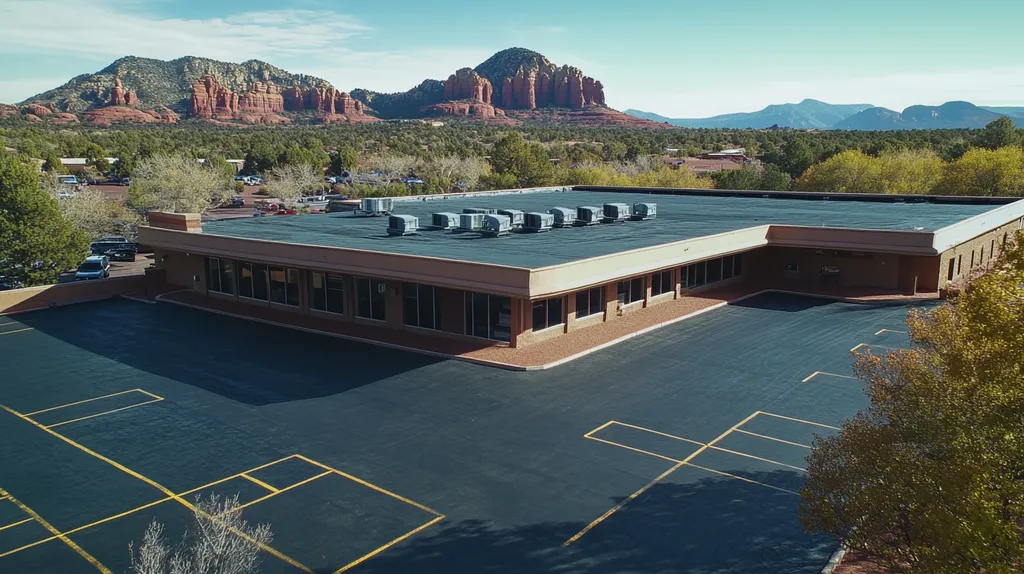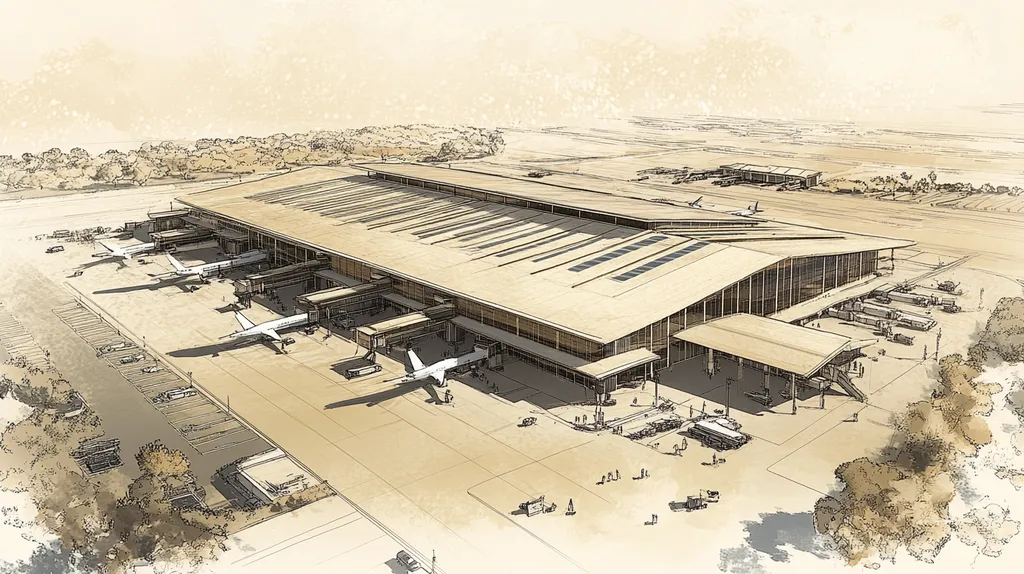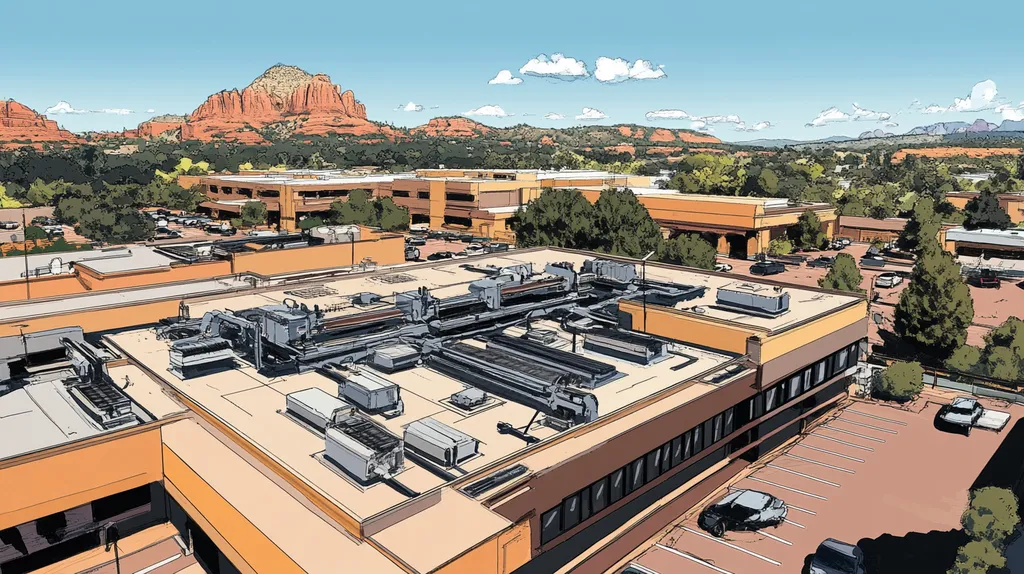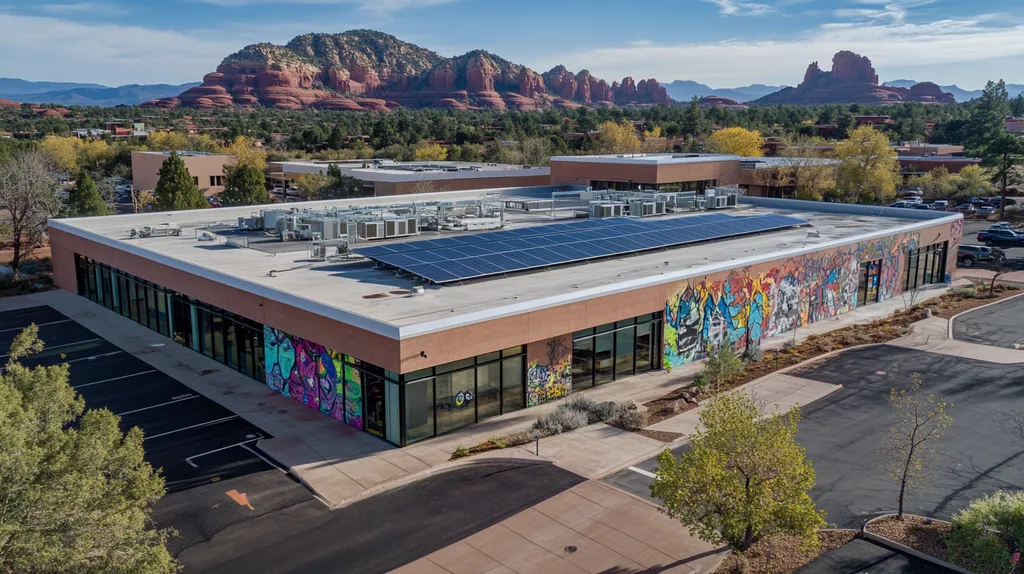Weather-related coating failures cost industrial facilities millions annually in repairs and business disruption. A single misapplied coating due to poor weather conditions can reduce a roof’s lifespan by 40-60%, while proper timing can extend protection for decades.
As climate patterns become increasingly erratic, facility managers must master the complex interplay between weather conditions and coating performance. Temperature swings, humidity levels, and precipitation timing can make or break a coating project.
This comprehensive guide examines critical factors in weather-impacted coating applications, from performance metrics to compliance requirements, equipping facility managers with actionable strategies for optimal results.
SECTION 1: PERFORMANCE FACTORS
The effectiveness and lifespan of roof coatings hinge significantly on the timing of their application. In today’s rapidly shifting weather patterns, facility managers must grasp how temperature and humidity impact overall performance. Inadequate application during adverse weather can result in costly repairs and a reduced lifespan of the coating. Attention to these performance factors is essential for achieving optimal results.
Coating Adhesion and Drying Time in Variable Weather
Coating adhesion is the backbone of any successful roofing project. When weather conditions fluctuate, challenges arise—strong winds or unanticipated rain can disrupt the application process. For example, applying a coating right before a rainstorm can lead to wash-off or inadequate adhesion, resulting in premature failure.
Additionally, drying times vary with weather changes. In cooler temperatures or high humidity, coatings can take much longer to set, delaying project timelines and affecting production in industrial facilities where every hour of downtime counts.
Facility managers should carefully review the manufacturer’s drying time recommendations for specific climatic conditions. Adhering to these guidelines enriches the chances of a successful application despite weather variances.
Key Action Items
Impact of Temperature and Humidity on Cure Rate
The cure rate of roof coatings is intricately tied to temperature and humidity. Higher temperatures can quicken the curing process, while lower temperatures hamper it, potentially affecting the coating’s sheen and durability. For example, many coatings should not be applied below a specific temperature threshold to ensure proper curing.
In high-humidity environments, moisture can interrupt the curing process, ultimately reducing coating performance. It is vital for facility managers to consult product specifications for acceptable humidity levels during application.
By leveraging weather forecasts and being mindful of seasonal trends, facility managers can schedule coatings during optimal conditions. This proactive strategy enhances the likelihood of achieving the desired performance outcomes.
Key Action Items
Product Selection Based on Regional Climate Conditions
The selection of the appropriate coating product is crucial and should align with the specific climate conditions of the region. Different coating systems are engineered to endure various environmental challenges, including UV exposure, moisture, and temperature variations. For instance, elastomeric coatings are often ideal for areas facing significant temperature fluctuations due to their flexibility.
When choosing roofing materials, facility managers must account for the local climate. Moisture-resistant coatings should be prioritized in humid regions to prevent mold and mildew, while UV-resistant products are critical in sun-drenched areas.
Consulting with local roofing professionals can yield valuable insights tailored to unique environmental challenges. A grasp of historical weather patterns further aids in making strategic decisions that significantly enhance roof coating longevity.
Key Action Items
SECTION 2: FINANCIAL CONSIDERATIONS
Weather-related delays in roof coating applications can have substantial financial consequences for facility managers. A single day lost to poor weather could rack up significant expenses, including labor costs and material wastage, as well as potential revenue losses from operational downtime. This highlights the critical need for proactive budgeting and strategic planning, which this section will cover through cost impacts, budget considerations, and an ROI analysis focusing on the long-term benefits of weather-resilient strategies.
Cost Impacts of Weather-Related Application Delays
Weather conditions like rain, snow, and extreme temperatures can halt roof coating projects, resulting in immediate financial impacts. Each lost day leads to additional costs, including labor and the risk of damage to unprotected building materials. For instance, a one-week delay due to rain can easily result in thousands of dollars spent on contractor fees alone.
Beyond direct costs, these delays can disrupt business operations and push project timelines past deadlines. Facility managers might encounter additional expenses related to lost productivity or even the need for temporary relocations if the workspace is affected. Understanding how weather can impact scheduling is vital for creating an accurate budget.
By tracking localized weather trends, facility managers can refine project timelines and improve financial forecasts. Better awareness of weather patterns helps prevent underestimating both the time needed for roof coatings and their associated costs, ensuring effective financial management even amid inclement conditions.
Key Action Items
Budgeting for Weather-Contingency Measures and Overruns
It’s essential for every roofing project to incorporate a budget specifically allocated for weather contingencies. Facility managers often neglect this aspect, leading to unexpected budget overruns when adverse weather occurs. A standard recommendation is to set aside at least 10-15% of the total project budget for weather-related incidents.
This contingency funding acts as a financial buffer against potential delays, ensuring that the organization can adapt to unforeseen challenges without straining overall project objectives. Managers who omit this financial cushion may find themselves scrambling to cover unexpected costs, which can derail planned timelines.
In addition to setting aside contingency funds, employing advanced planning tools can greatly improve weather assessment. Utilizing software that predicts weather conditions allows for better project scheduling and can reduce surprise expenses linked to mismanaged application timing.
Key Action Items
ROI Analysis: Longevity vs. Temporary Weather Setbacks
Investing in high-quality roof coatings often yields long-term savings that can surpass the costs incurred by temporary weather setbacks. These advanced coatings have the potential to significantly extend the lifespan of a roof, encouraging facility managers to focus on durability rather than immediate expenditures. A well-maintained roof can also enhance energy efficiency and lower maintenance costs over time, ultimately fostering a positive return on investment.
However, if the application is delayed due to weather impacts, managers must evaluate the opportunity costs. Prolonged delays can lead to existing roofs deteriorating more quickly, negating the benefits that new coatings would provide. For this reason, facility managers should weigh the risks associated with delays alongside the long-term value of timely application in their ROI calculations.
In assessing returns, it’s crucial to include factors such as savings from fewer repairs and reduced energy expenses, as well as the overall longevity of the roofing system. While high-quality materials may demand a higher initial investment, they typically offer superior returns, positioning them as a smart choice for the future.
Key Action Items
SECTION 3: COMPLIANCE REQUIREMENTS
Navigating compliance requirements is paramount for successful roof coating applications. Failing to meet these standards can lead to hefty financial losses, voided warranties, and serious regulatory penalties. For instance, applying a coating under improper weather conditions can compromise its integrity, resulting in premature failure. Facility managers must strictly adhere to both manufacturer specifications and local regulations to safeguard their projects.
Manufacturer Specifications and Warranty Weather Restrictions
Roofing manufacturers provide specific guidelines regarding optimal weather conditions for coating applications. These guidelines typically outline the necessary temperature ranges, humidity levels, and moisture conditions. For instance, using a roof coating in high humidity can trap moisture underneath, leading to peeling and reduced durability.
Warranties may be rendered void if the application doesn’t comply with these specifications. Therefore, facility managers need to thoroughly review warranty terms to prevent disputes with manufacturers later down the line. Meticulously documenting environmental conditions during application will reinforce warranty claims in the event of product failure.
Staying current with the latest manufacturer product guides is essential, as these may change with advancements in technology and materials. Engaging with a manufacturer’s representative for clarity before application can also mitigate potential issues, ensuring compliance and longevity.
Key Action Items
Local Building Codes and Environmental Regulations
Local building codes and environmental regulations are critical components of roofing projects. Facility managers must be well-versed in these regulations to ensure compliance before starting work. Failing to meet these standards can bring about fines, project delays, or even full work stoppages.
Building codes typically specify essential elements like required materials, structural support, and specific installation practices. For example, some regions may restrict certain chemical components in coatings due to environmental concerns. Clarity on these requirements is vital for remaining compliant.
Additionally, many localities impose seasonal restrictions on roofing work, particularly in areas susceptible to harsh winters or heavy rains. Familiarity with these local rules and adjusting project plans accordingly is essential. Consulting with local enforcement officials can offer vital clarity on these requirements, helping to avoid costly delays.
Key Action Items
Documentation Protocols for Weather-Interrupted Projects
Robust documentation is vital for any roofing project interrupted by adverse weather. Facility managers must keep thorough records of all environmental conditions encountered and the decisions made throughout the project. This includes precise details such as temperatures, humidity levels, and any weather-related delays.
Comprehensive records bolster protection against warranty claims. Should disputes arise, solid documentation demonstrates compliance with manufacturer guidelines and outlines the steps taken to address weather-related issues during the project.
Additionally, sharing this documentation with all stakeholders fosters transparency and ensures everyone is informed and can react effectively to weather challenges. Ultimately, meticulous documentation not only supports compliance but also enhances accountability and project performance.
Key Action Items
SECTION 4: RISK MANAGEMENT
Weather plays a critical role in the successful application of industrial roof coatings. Unexpected changes can lead to expensive damages and project delays. For instance, a single week of adverse weather can cost thousands in lost productivity and accelerated roof deterioration. Facility managers must anticipate environmental factors to avoid costly disruptions. This section explores risk assessment, moisture management, and mitigation strategies to ensure timely and effective coating applications.
Assessing Weather Forecast Reliability and Contingency Planning
Facility managers often face a challenge when relying on weather forecasts for effective project planning. Weather predictions can change rapidly, creating uncertainty that disrupts operations. By utilizing multiple reliable weather sources, managers can enhance their forecasting accuracy but must also develop contingency plans for unforeseen conditions.
For example, while scheduling coating applications during warmer months may seem prudent, surprise rainstorms can completely alter timelines. Establishing a comprehensive weather response plan, complete with clear procedures, enables teams to adapt quickly to changing conditions.
Furthermore, contingency guidelines should specify materials and options for coverage when rain threatens. Quick access to tarps or temporary protective coverings helps mitigate losses. Regular communication with contractors regarding potential weather impacts fosters alignment with project goals, reducing confusion when forecasts change.
Key Action Items
Minimizing Moisture-Related Coating Failures
Moisture is a leading cause of coating failures, resulting in loss of adhesion and accelerated deterioration. It is essential to understand the moisture content of the substrate prior to application. Roofing surfaces should be completely dry, as moisture levels above 15% can jeopardize adhesion.
Facility managers should perform moisture tests before commencing a project. If conditions are not optimal, they must postpone the application to protect the long-term investment. Prompt assessments enable corrective actions, such as using dehumidifiers or circulation fans in humid environments.
Moreover, exceeding temperature limits during application can worsen moisture issues. Coatings need to be applied within the temperature range specified by the manufacturer to ensure optimal curing times. Implementing a robust moisture management strategy minimizes risks while maximizing the effectiveness and longevity of the coatings.
Key Action Items
Mitigating Wind and Debris Effects During Application
Wind represents a significant risk during roof coating applications, potentially causing overspray and contamination. When wind speeds exceed safety guidelines, it’s crucial to halt operations until conditions improve. Failure to manage wind risks can compromise coating integrity and appearance.
Additionally, debris can become airborne in windy conditions, leading to unwanted texture in the finish. Proper site preparation before coating—such as removing loose materials and securing equipment—can help prevent additional risks.
Utilizing high-quality protective barriers can shield work areas from wind and flying debris. Furthermore, scheduling work during times of low wind helps ensure higher application quality. Training the workforce on handling coatings in adverse weather promotes safety and efficacy across the project.
Key Action Items
SECTION 5: OPERATIONAL PROCEDURES
Timely and effective application of roof coatings is critical to ensuring both durability and protection. Weather conditions can drastically influence these timelines, leading to costly delays and reduced coating performance. For instance, poor scheduling may allow moisture intrusion, which compromises adhesion. Effective operational procedures focusing on scheduling, surface preparation, and application techniques are essential for facility managers to navigate these challenges.
Scheduling Best Practices for Optimal Weather Windows
Scheduling work around reliable weather forecasts is a key operational procedure. Facility managers should monitor local weather conditions regularly and aim to plan coating applications during periods of low humidity and stable temperatures. Ideally, coatings are applied when temperatures range from 50°F to 90°F to allow for proper curing.
It’s crucial to remain vigilant for potential weather fluctuations. An unexpected rain shower could derail a coating job and delay the reopening of the facility. Therefore, establishing a flexible timeline enables teams to adapt quickly to any changes.
Long-term planning is equally important. Familiarity with seasonal weather patterns helps managers pinpoint the best months for roof coating projects, reducing risks associated with unpredictable conditions.
Key Action Items
Surface Preparation and Moisture Testing Protocols
Successful coating applications hinge on meticulous surface preparation, closely influenced by weather. Before applying any coating, thorough cleaning and moisture testing are crucial to confirm that surfaces are ready. Environmental conditions significantly impact these preparations.
Moisture meters can effectively identify hidden dampness in roofing materials. If the substrate is damp due to prior rain, it’s vital to carry out drying methods before continuing. Failing to conduct adequate moisture testing can result in poor adhesion and subsequent coating failure.
Cleansing techniques should also align with the existing weather. In wet or humid environments, additional drying time may be necessary after washing to achieve optimal adhesion. Facility managers must remain attentive to the current weather conditions throughout surface preparation.
Key Action Items
Application Techniques for Challenging Weather Conditions
Adventurous application techniques can salvage projects impacted by unfavorable weather. Using low-temperature coatings can be advantageous during cooler months, as these specialized products cure effectively even in lower temperature ranges.
Windbreaks or tarps can also significantly mitigate the effects of wind during application, which may lead to overspray and an uneven finish. Implementing protective measures greatly reduces these associated risks.
Furthermore, scheduling application tasks during the drier parts of the day—typically early morning—can enhance results by decreasing environmental challenges like dew or rising temperatures.
Key Action Items
SECTION 5: OPERATIONAL PROCEDURES
Timely and efficient application of roof coatings is essential for ensuring durability and protection. Weather conditions can dramatically influence these timelines, leading to costly delays and compromised coating performance. For example, inadequate scheduling may result in moisture intrusion, which negatively affects adhesion. Facility managers must adopt effective operational procedures that focus on scheduling, surface preparation, and application techniques to navigate these challenges successfully.
Scheduling Best Practices for Optimal Weather Windows
One of the most critical operational procedures involves strategically scheduling work according to reliable weather forecasts. Facility managers should monitor local conditions regularly, planning coating applications for periods of low humidity and stable temperatures. Ideally, coatings should be applied when temperatures are between 50°F and 90°F to ensure optimal curing conditions.
In addition, proactive scheduling must account for potential weather fluctuations. An unexpected rainstorm can easily derail a coating job, causing delays in reopening the facility. Establishing a flexible timeline allows teams to adapt swiftly to any changes in the weather forecast.
Long-term planning is equally important. Familiarity with seasonal weather patterns assists managers in identifying the best months for roof coating projects, minimizing risks associated with unpredictability. By implementing a strategic scheduling approach, facility managers can reduce disruptions and ensure high-quality results in roof coating applications.
Key Action Items
Surface Preparation and Moisture Testing Protocols
Effective surface preparation is vital for successful coating applications, with weather conditions significantly impacting this step. Before applying any roof coating, thorough cleaning and moisture testing are crucial to ensure that the surface is ready. Environmental factors play a key role in these preparations.
Using moisture meters is essential for identifying any hidden dampness in roofing materials. If the roofing substrate is damp due to prior rain, it must be addressed through appropriate drying methods before proceeding. Neglecting moisture testing could lead to poor adhesion and premature coating failure.
Furthermore, cleaning methods should be adapted according to the prevailing weather. Wet or humid conditions may necessitate additional drying time after washing the roof to achieve optimal adhesion. Facility managers must remain vigilant regarding the weather during surface preparation to ensure quality outcomes.
Key Action Items
Application Techniques for Challenging Weather Conditions
In the face of challenging weather conditions, employing innovative application techniques can help salvage potentially problematic projects. For example, using low-temperature coatings can facilitate successful applications during cooler months, as these specialized products cure effectively even in lower temperature ranges.
Moreover, using windbreaks or tarps can significantly mitigate the effects of windy conditions during application, reducing the risks of overspray and uneven finishes. Implementing these protective measures is essential to maintain coating integrity.
Additionally, scheduling work during the drier parts of the day often enhances application quality. Early morning slots typically present fewer environmental challenges, such as dew or rising temperatures, ensuring a smoother application process and a superior final result.
Key Action Items
Looking Ahead
Weather-related coating failures cost industrial facilities over $2.3 billion annually in repairs, downtime, and premature roof replacement.
As climate patterns become increasingly erratic, facility managers must adopt comprehensive weather monitoring and response protocols to protect their coating investments.
The stakes are clear: a single misapplied coating due to poor weather conditions can reduce a roof’s lifespan by 40-60%, while proper timing and application can extend protection for decades.
Success requires rigorous adherence to manufacturer specifications, meticulous documentation, and strategic scheduling around optimal weather windows.
By implementing the strategies outlined in this guide, facility managers can navigate weather challenges while ensuring maximum coating performance and ROI.
FREQUENTLY ASKED QUESTIONS
Q. How do weather conditions affect commercial roof coating application?
A. Weather conditions significantly influence adhesion and drying times during application. Factors like temperature and humidity can lead to delays and increased costs if not managed properly. Facility managers should monitor weather patterns and adhere to manufacturer’s specifications to ensure optimal application outcomes.
Q. What are the financial impacts of weather delays on industrial roof projects?
A. Delays due to weather can result in increased labor costs, materials wastage, and lost revenue from operational downtime. A proactive budgeting approach, including a contingency fund for unexpected delays, can help offset these financial burdens and maintain project timelines.
Q. How do local building codes affect commercial roof coating applications?
A. Local building codes impose regulations regarding materials, installation practices, and environmental impact that must be adhered to during roof coating. Familiarizing yourself with these regulations is crucial to avoid penalties and ensure successful project completion.
Q. What risks should facility managers consider when applying coatings?
A. Facility managers need to assess risks such as moisture levels, wind conditions, and unforeseen weather changes. Implementing a thorough risk management strategy, including moisture testing and contingency plans, can minimize potential issues and protect the longevity of the coatings.
Q. How can weather conditions influence surface preparation for coatings?
A. Weather conditions directly affect the moisture content and cleanliness of roofing surfaces. It is essential to conduct thorough cleaning and moisture testing in line with current weather, ensuring surfaces are adequately prepared to achieve proper adhesion and avoid coating failure.
Q. What application techniques are effective during challenging weather?
A. Using low-temperature coatings and employing windbreaks can help mitigate challenges posed by adverse weather. Additionally, scheduling applications during more favorable weather conditions, like early in the day, enhances the overall quality and durability of the coatings.
Q. What should I include in my documentation for weather-interrupted projects?
A. Documentation should record environmental conditions, decisions made during interruptions, and any actions taken to address weather impacts. Accurate records support compliance and warranty claims, ensuring transparency among all stakeholders involved in the project.










